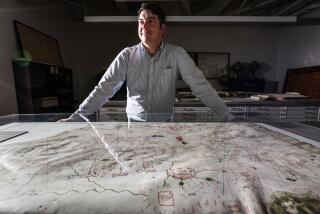An acute case of ‘topophilia’
- Share via
The La Canada home office where Claude Hulet plots his charts is not much wider than a sailboat’s beam or higher than a summer swell. A standing file on the desk holds his tools: a U.S. Power Squadrons Course Plotter #500, two triangles marked with degrees of a compass, a C-Thru parallel rule. And, of course, the charts -- modern maritime maps with Hulet’s neatly drawn dream of a 500-year-old quest.
Tall and limber at 83, Hulet is a navigator without a ship. For nearly 15 years, the retired professor of Portuguese literature, World War II veteran and Coast Guard auxiliary officer has traced the path of Vasco da Gama, who sailed around the African cape on his way to India in 1497. “I look at [the route] as a pilot of the times,” he said.
Portuguese explorer Da Gama made three trips to India -- in 1497-98, 1502 and 1524 -- and it’s a national pastime in Portugal to recount his voyages, particularly his first, in the way Americans refight the Civil War.
The reputation of the captain who fired on locals to demonstrate “how much harm we could do them if we wanted,” as Da Gama was quoted in the only eyewitness account of the 1497 trip, has suffered in the last decade. But his 84-day open-sea voyage from the Cape Verde Islands off Senegal to the Cape of Good Hope stands as a maritime feat -- and a mystery. “Few figures in world history are so well known and so obscure as Vasco da Gama,” wrote one historian.
Portuguese pilots sailed by dead reckoning, using simple instruments, with only a basic grasp of longitude to measure their east-west travel. Hunger, loneliness and disease stalked the crews.
Da Gama’s ship log only hints at the desperate days of calm and deprivation in the unknown waters of the South Atlantic. The charts on which his pilots tracked the passage did not survive.
Few maps withstood the rigors of open-sea sailing, said UCLA geographer Denis Cosgrove: “Any navigational map would be destroyed in the act of using it.”
Yet such a map would provide a window into the stress and triumph of travel, and a token of what Cosgrove calls “topophilia”: the ways in which people become emotionally attached to places.
“The map allows you literally to dream of places and fill them with all sorts of fantasies,” he said.
Hulet’s solitary focus on Da Gama started with a lifelong exposure to the explorer’s myth and a late-life love of sailing. It was fueled by a growing infatuation with Portugal.
He never lived in Portugal, but he studied Spanish and Portuguese, served in the Army Air Corps in northern Brazil and worked for the State Department. When he first went to Portugal in 1972, he recalled, “I had a vibration go through me as if I had been there before.”
Hulet’s wife of 21 years, Maria Jose, is Portuguese, and the Serra da Estrela sheepdog who broods massively in his driveway is called Camoes, after the 16th century poet who wrote of his countrymen, “If there had been any more of the world, they would have discovered it.”
But his adopted homeland has not always returned his embrace.
When Hulet revealed his theory of Da Gama’s path to the African cape at a Lisbon conference marking the 500th anniversary of the first voyage, “I was booed,” he said, for reading in English and for disputing the claims of the former Portuguese naval officers who had previously sketched the route.
The response stung Hulet. He stopped reading and told the audience, in Portuguese, “that ‘everything that you write in Portuguese is to bury [the truth].’ I hit them where it hurt,” he recalled, smacking his fist into his palm, tears quivering in the corners of his eyes.
UC Santa Barbara Portuguese professor Francis Dutra, who witnessed the exchange, sympathizes with his friend of more than 20 years. “It’s almost a cottage industry in determining these routes,” he said.
Hulet plans to publish his charts and a narrative of Da Gama’s journey, and he hopes someday to return to Portugal, though his project keeps him landlocked in the shadow of the San Gabriels.
“If I go, I’m not sitting here at my desk trying to refine my book,” he said.
So he stays in his low-hung office, bowed over his charts, imagining the moment Da Gama rounded the Cape, looked up from his maps and sailed free.
More to Read
Sign up for Essential California
The most important California stories and recommendations in your inbox every morning.
You may occasionally receive promotional content from the Los Angeles Times.













